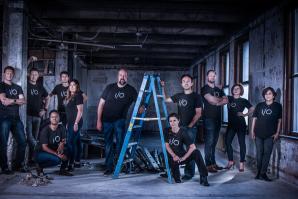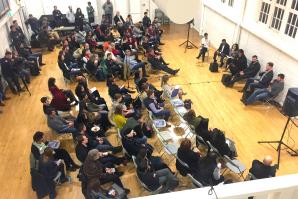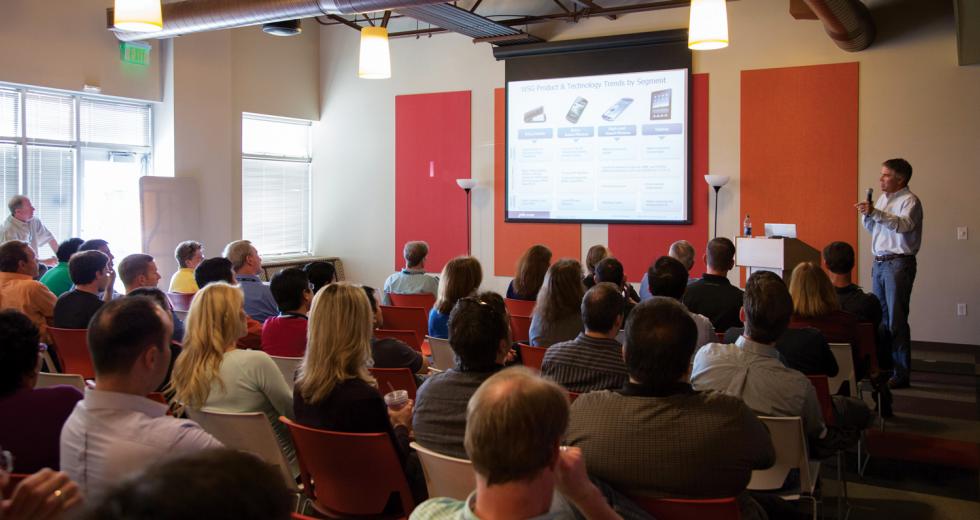Like attracts like. It’s the principle belief behind the law of attraction, which states that people tend to seek out or be attracted to those who are similar or like-minded. The same idea can be applied to the business world, in that companies often gather — or cluster — around their successful peers in hopes of sharing services while improving efficiency and productivity.
When done so successfully, these groupings are commonly referred to as innovation clusters. They emerge when a network of companies coexist within a geographic location, allowing each to collaborate and compete in a way that delivers greater productivity gains than they would achieve in isolation, according to a briefing paper in The Economist. Silicon Valley is a prime example. Innovative people are attracted to such clusters, breeding a cross-pollination of ideas and mutual benefit from one another’s successes, the briefing explains.
“The notion of innovation is how you create new services and products in a way that allows the community to capture jobs,” says Barry Broome, CEO of the Greater Sacramento Economic Council.
The area has recently experienced the consequences of companies struggling to stay competitive. In April, Aerojet Rocketdyne announced it was shuttering its Rancho Cordova manufacturing operations and eliminating or relocating 1,100 of its 1,400 local jobs. Hewlett Packard once employed 6,000 people at its Roseville offices, but after 15 years of downsizing that number sits closer to 2,000.
But Broome says these shifts were inevitable, as the companies are undergoing major reconstruction efforts designed to save operation costs, and it’s unfair to blame the region for losses that would have occurred regardless of location. Instead of fighting to keep what’s no longer working, Broome says the idea is to allow it to fall off, and focus on pairing our assets and talents with industries of the future.
“We’re not going to replace jobs,” Broome says.“You have to be vigilant with industries and plan for them to go away.”
Related: Is it Time for a Technological Shift?
While Sacramento didn’t capitalize on the digital revolution (developer and coding talents weren’t as strong here as in the Bay Area and Los Angeles), it’s time to ensure the area assesses how its talent pool aligns with industries of the future, Broome says. “We weren’t deep in software engineers, we didn’t have a deep developer or coding community,” he says. Without careful planning and strategic recruitment, Broom says the region will be forced into a “commodity player” status — buying goods from elsewhere instead of creating them, and jobs, from home.
The Great Recession hit California’s Capital Region particularly hard, in part due to our reliance on government and construction industries. Focusing on growth in other industries will make the area’s economy more resilient during future economic downturns.
In a lengthy Valley Vision report titled “Next Economy” published in 2013, six industry cluster areas — advanced manufacturing, clean economy, education and knowledge creation, food and agriculture, information and communication technologies, and life sciences and health services — were identified through research. These existing high-growth areas, identified as “critical to the region’s economy,” have the greatest job creation and investment capacity.
The clusters generate an economic impact of nearly 38 percent of the region’s total domestic output, or about $67 billion, the report states. And they’re somewhat clustered geographically, as the report pooled information from the six-county Sacramento region — El Dorado, Placer, Sacramento, Sutter, Yolo and Yuba counties.
Some clusters are fairly obvious, as in Folsom which is home to tech companies such as Intel, PowerSchool and Micron Technologies, or in Sacramento which hosts several hospitals that anchor it as a life sciences and health services hub.
Other anchors include UC Davis, the area’s only public research university.
“Being the capital city, government will always be important, and we want to continue to have that dominance, but to expand upon the foundation that government and construction have on our economy,” says Christine Ault, who served as project manager of Next Economy.
The largest cluster with more than 140,000 jobs, life sciences and health services, includes five sub sectors — hospitals, ambulatory health care services, nursing and residential care facilities, social assistance and life sciences.
Education and knowledge creation is the second largest cluster with more than 100,000 jobs, and includes five sub sectors — private and public education institutions, education support services, publishing and broadcasting. This includes the area’s two universities, seven community colleges and several private education systems.
Advanced manufacturing, with fewer than 20,000 jobs, includes six sub sectors — aerospace, chemical, computers and electronics, machinery, plastic products and transportation manufacturing.
Clean economy also includes six sub sectors — energy and resource efficiency, renewable energy, sustainable farming, advanced transportation, environmental compliance and recycling/waste reduction.
What Businesses Say
Over at Folsom’s Micron Technology, which creates memory products that enable mobile phones, computers and the internet to run faster, Amit Gattani considers being in the Capital Region an asset. He values the proximity to tech giants such as Intel, Hewlett Packard and Oracle as part of the greater cluster, and works to strengthen the relationships Micron has with research faculty and students at UC Davis.
“This leads to critical mass of talent pool in the area that is necessary to support diversity of thinking, thought leadership, collaboration and ultimately innovation.” Amit Gattani, Micron Technology
For example, “there is a very strong talent pool and innovation culture around flash storage technologies in this area, with talent pool coming from companies like Micron, Intel, HP, NEC, Sierra Logic, Emulex, Marvell, PMC Sierra and many others over (the) past 10 to 15 years,” he says. “This leads to critical mass of talent pool in the area that is necessary to support diversity of thinking, thought leadership, collaboration and ultimately innovation.”
At Evolve Biosystems, a biotech company just minutes from UC Davis (whose founders are research faculty) focused on gut microbiome, the proximity to the university allows for an ease in intellectual exchange, as well as the founders being present for daily operations, says Director of Scientific Communications Tracy Shafizadeh. She considers Evolve Biosystems to be at the intersection of two clusters — life sciences and health services, and food and agriculture, because the company produces a food product that restores babies’ gut microbiome. And UC Davis, specifically its Office of Innovation, is part of the picture.
But as far as others specifically in the microbiome science community, Evolve Biosystems is unique in that there aren’t any others doing the same work, Shafizadeh says.
What’s Needed for future growth
When the Sacramento Regional Technology Alliance shut down in 2015, many of its programs — AgStart, CleanStart, MedStart, TechStart and VentureStart — went with it, with those remaining trickling along under new leadership, says Eric Ullrich, co-founder of Hacker Lab.
SARTA, which was a nonprofit organization designed to encourage and champion technology ventures in the Capital Region, launched in 2001. It became one of the first six iHubs in the state in 2010, meant to foster innovation and trade regionally through locally designed innovation hubs.
After a series of leadership changes, including then-CEO Meg Arnold who stepped down in 2014, the organization splintered a year later.
Some of its main programs — AgStart, CleanStart and MedStart — have new leadership. SARTA’s board transitioned its assets to the nonprofit arm of I/O Labs, which launched in 2016 as an entrepreneurial incubator and accelerator program. It also took over as the regional partner for the state’s iHub program. This new venture is set to open later this year in downtown Sacramento.
“All these programs take leadership to develop, program management and programming events, to build a community within these sectors,” Ullrich says. “It’s especially hard when you’re trying to build among companies that are trying to focus on the bottom line.”
In September, UC Davis entered into collaboration agreements that would bring Urban Hive and I/O Labs into the Venture Catalyst Distributed Research Innovation & Venture Engine network of startup incubators. These partnerships combine the Urban Hive and I/O Labs’ resources with those available through UC Davis-affiliated startups through Venture Catalyst to support the translation of groundbreaking research and business concepts into commercial products and services, according to UC Davis News.
UC Davis’ new chancellor, Dr. Gary May, took the helm in August 2017. Formerly the dean of engineering at Georgia Tech, May was instrumental in a massive 1.4 million-square-foot urban mixed-use development plan called Technology Square.
Today, it’s home to more than 20 innovation centers and corporate labs, with Boeing among its newest tenants. “Since it first opened 13 years ago, Technology Square in Midtown Atlanta has rapidly become one of the leading regional innovation hubs in the southeastern U.S.,” says Georgia Tech President G.P. “Bud” Peterson. “Tech Square promotes and facilitates innovation and collaboration between businesses and industry and the Georgia Tech community.”
And May already has some ideas for taking what he learned with Technology Square and applying it to Sacramento. Earlier this summer, he and Sacramento Mayor Darrell Steinberg visited the Midtown Atlanta-based destination.
“I’m excited to work with UC Davis and Sacramento leaders to establish partnerships that will drive economic and workforce development, grow investment, and spur our thriving innovation ecosystem,” Steinberg said in a UC Davis release about the visit. “Exploring models like Atlanta Tech Square will help to more fully inform how our city can serve as a partner in promoting greater regional collaboration so we can continue to compete globally.”
Recommended For You

The Next Act
New entrepreneurial workspace I/O Labs is in the limelight, poised to become the flagship California Innovation Hub — but Sacramento has seen this show before
Innovation cannot occur within a vacuum. While it’s nice to have an office door that shuts the world out, successful entrepreneurs understand that the best ideas are molded through collaboration.

The Way to ‘Innovation City’
California Groundbreakers and Comstock’s host panel on innovation in Sacramento
Can Sacramento become a capital of entrepreneurship? Yes, agreed panelists at an event focused on innovation in the city, held Jan. 23 at the E. Claire Raley Studios for the Performing Arts in Midtown and co-hosted by California Groundbreakers and Comstock’s magazine.



